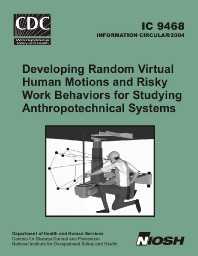Mining Publication: Developing Random Virtual Human Motions and Risky Work Behaviors for Studying Anthropotechnical Systems
Original creation date: March 2004
A computer model was created that generates contact data by means of simulation while altering several variables associated with the machine and its operator. These variables include work environment, the operator's anthropometry, work posture, choice of risky work behavior, and the machine's appendage velocity. In the model, a contact means two or more objects intersecting or touching each other, e.g., the appendage colliding with the operator's hand, arm, head, or leg. This report documents the code development of special features of the computer model, random virtual human motions and behaviors, which made it possible for researchers to study hazardous interactions, such as contacts between the operator and machine. The original idea for random virtual human motions began with the need for a model that, when simulated, would experimentally mimic machine and human actions that could cause actual injuries or fatalities in the workplace. Injury incident investigation reports do not usually contain enough information to aid in studying this problem, and lab experiments with human subjects are also not feasible because of safety issues and ethical issues. Early investigation that evaluated the feasibility of random motions resulted in a primary programming structure and building blocks for code expansion. Basic motions and standard derivation data provided random parameters for the operator's movement in the random motion code. Experimenting with basic motions in preliminary models helped researchers devise a random motion technique that worked with xyz motion parameter values from basic motion parameters. Both values were the building blocks used in motion commands that comprised the core of the random motion code. When the code is executed in a three-dimensional computer model, it generates realistic starting positions for the operator's (virtual human) body and body parts and realistic motions mimicking a work sequence with a valid range of variation in movements. Researchers developed several rules for the random motion technique that, when applied, will maintain directional integrity of a virtual human's basic motions. From previous research, researchers formulated the algorithm that determines the behavior during machine operation. The decision algorithm was needed by the random motion code to randomly select what behavior to use for a simulation execution for a realistic representation of the operator's motions and risky behaviors during work tasks. The operator's chance of avoiding the moving appendage was also a concern to ensure that data reflecting a near-miss would not be considered a contact. Therefore, to filter a database obtained from simulations for actual contacts, it was necessary to track the operator's field of view and determine from this information when the appendage is in and out of the operator's view. NIOSH researchers successfully applied random motions and risky behaviors to examine the speed range of a roof bolter machine appendage for different workplace scenarios and compare statistically which is most likely to cause contacts (and possible injuries) to miners. Researchers in this study believe that the use of such simulations, treated with advanced statistical procedures, are extremely useful tools to evaluate the hazards of tasks where it is not possible to perform experiments with human subjects.
Authors: DH Ambrose
Information Circular - March 2004
NIOSHTIC2 Number: 20024566
Pittsburgh, PA: U.S. Department of Health and Human Services, Public Health Service, Centers for Disease Control and Prevention, NIOSH, DHHS (NIOSH) Pub No. 2004-130, Information Circular 9468, 2004 Mar; :1-26
See Also
- Development and Application of Reservoir Models and Artificial Neural Networks for Optimizing Ventilation Air Requirements in Development Mining of Coal Seams
- Machine Injury Prediction by Simulation Using Human Models
- Mining Roof Bolting Machine Safety: A Study of the Drill Boom Vertical Velocity
- Modeling and Prediction of Ventilation Methane Emissions of U.S. Longwall Mines Using Supervised Artificial Neural Networks
- Modernization and Further Development of the NIOSH Mine Emergency Response Training System (MERITS), Phase 1
- Motion Editing and Reuse Techniques and Their Role in Studying Events Between a Machine and its Operator
- A PC-Based Monitoring System for Mine Hoisting
- SPONCOM - A Computer Program for the Prediction of the Spontaneous Combustion Potential of an Underground Coal Mine
- Technology News 549 - MFIRE 3.0 - NIOSH Brings MFIRE into 21st Century
- Verification and Validation of Roof Bolter Simulation Models for Studying Events Between a Machine and its Operator
- Content source: National Institute for Occupational Safety and Health, Mining Program


 ShareCompartir
ShareCompartir
